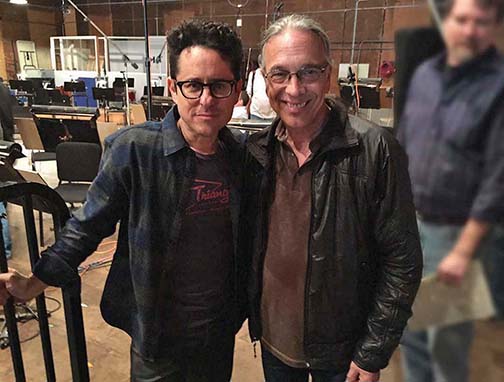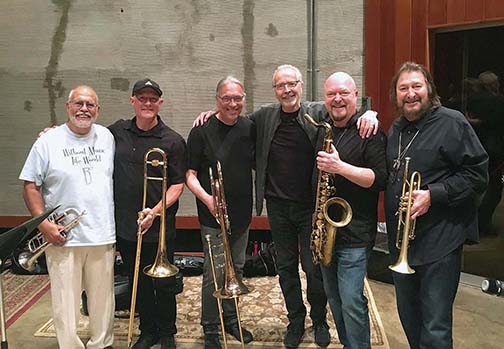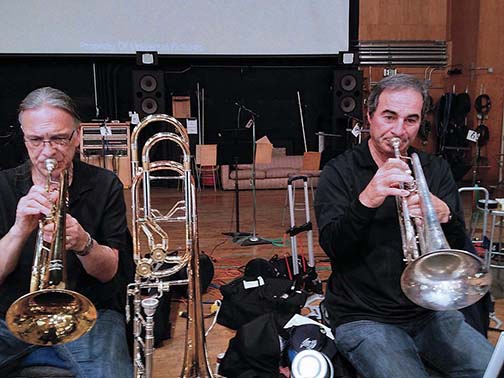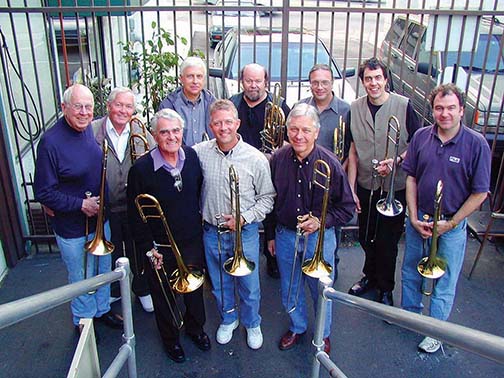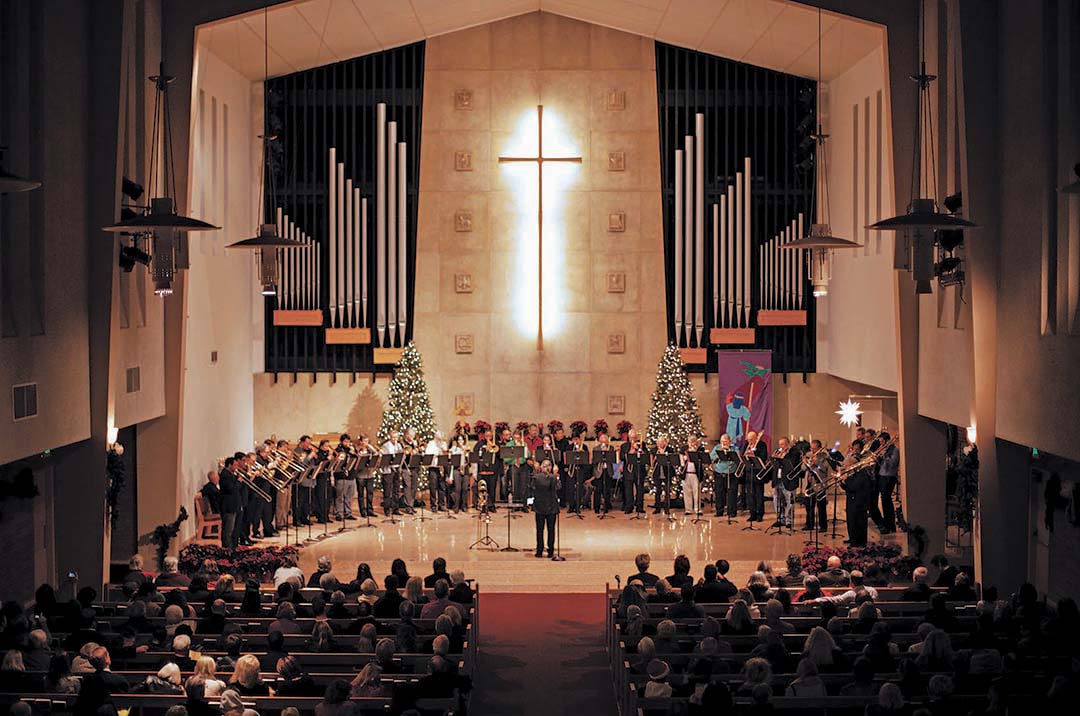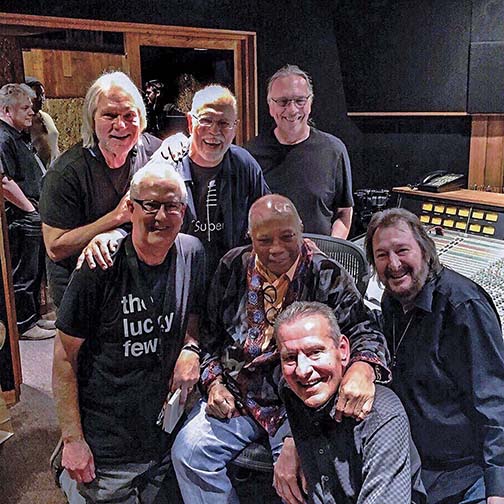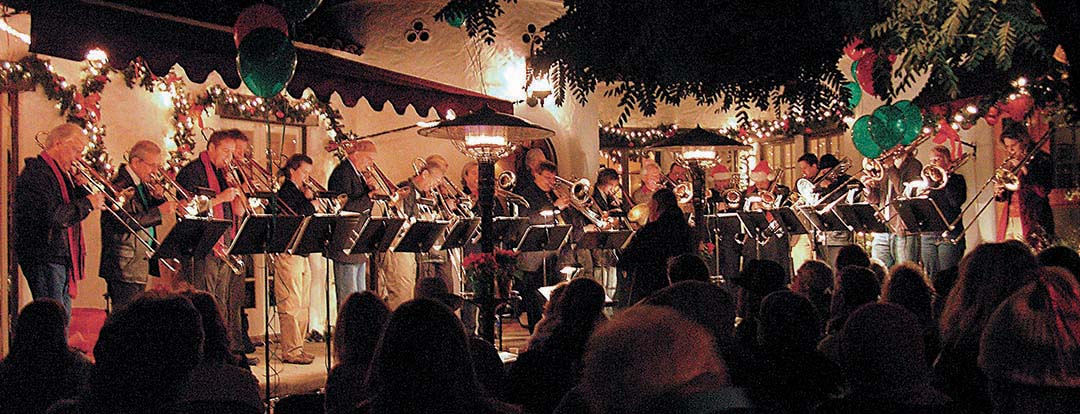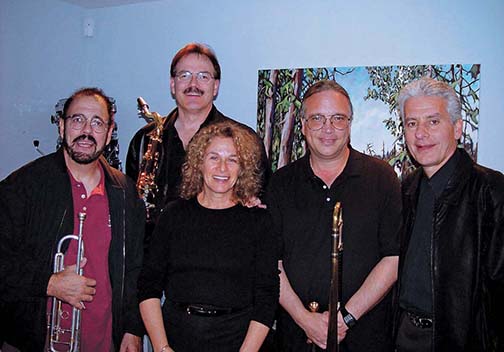ITA 2019 President's Award Recipient: Bill Reichenbach
by Antonio J. García
ITAJ Associate Jazz Editor
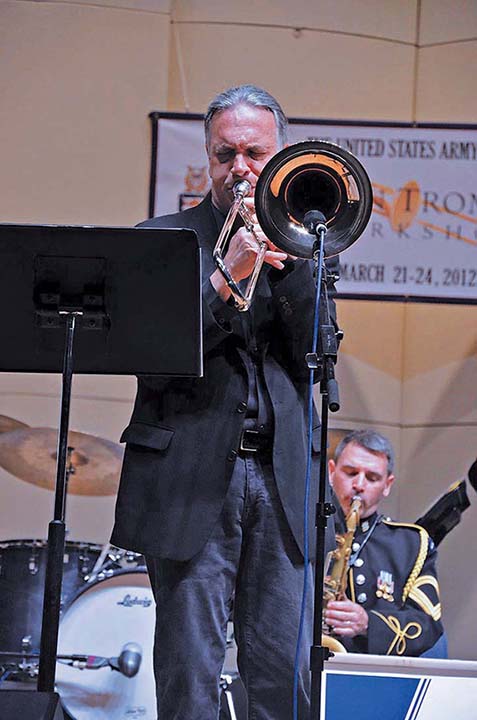 |
Bill soloing on bass trombone with the U.S. Army Blues at the Eastern Trombone Workshop. all photo credits: |
I heard Bill for the first time in my life on Buddy Rich’s album STICK IT within Antonio Carlos Jobim’s beautiful “Wave,” and I was so impressed. During the 2000 ITF in Utrecht I had my first live experience hearing him, and his jazz concert together with Michael Davis was for me one of the highlights of that event. We worked together during the first Dutch Bass Trombone Open in 2006; and since then I have been 100% sure that this man is a real artist, with a completely authentic style, an amazing sound, playing both ballads and virtuoso improvisations with the best possible notes. Besides all of this, Bill is a wonderful person, a gentleman pur sang! I’m so happy to be able to present this award to one of the most iconic and inspirational players ever!
—Ben van Dijk, President, International Trombone Association
Bill’s tenor and bass trombone work in particular have been a great inspiration to me for longer than I should say. I share his shuffle-solo on Toshiko Akiyoshi’s “Tuning Up” every year with students and educators as but one great example of blending improvised melody, intense rhythmic groove (and the willingness to inflect styles within it), and command of the chord changes—all wrapped into one lyrical package that simply sounds like a fun time, virtually disguising the depth of knowledge and craft involved. His wry humor, warm demeanor, and willingness to share with surrounding musicians only make his contributions to the profession more accessible. I interviewed Bill in May 2019 to gain insights into his background, influences, views, and future plans.
—Antonio García
Imprint
AG: If you would, with such a varied and accomplished career, please share with us just a half-dozen or less experiences in which sharing music as a performer or arranger changed your life in some way—preferably for the better! Just one- or two-line snapshots and why so important to you. And we’ll understand that you’re leaving hundreds of other occasions out.
BR: This is a hard question. I guess from my own personal standpoint, my initial contacts with my three teachers were fairly life-changing, each in a different time of my musical development.
Chuck Mangione’s Friends and Love concert in the Eastman Theatre in 1970 was quite an amazing thing. The music was very fresh at that time. Trying to combine jazz and pop styles with large orchestra was something that a lot of the younger arrangers at the school were experimenting with. And playing with that great rhythm section and the soloists was always exciting.
AG: Interesting that you mention that concert first, which you performed under Chuck’s baton with the Rochester Philharmonic and others and which became a PBS television special, as you know. But you don’t know that that broadcast made it to my house in New Orleans when I was just starting on the trombone and getting serious about music, and that TV special had a huge impact on me. I bought the double-album (and its sequel) and was fascinated with studio orchestras. More than a decade later, while soundchecking on the Eastman stage as a member of its Jazz Ensemble and as a graduate jazz composition major, I suddenly recalled that album and how it was recorded on that stage—even with some of the musicians I was studying with there, now faculty. All my little hairs rose. And I still have that album. But let’s get back to other life-changing musical experiences of yours.
BR: Playing the opening of the Kennedy Center in Washington, D.C., performing the Bernstein Mass and subsequently recording the piece with Mr. Bernstein was a very memorable several weeks in 1971.
With “Star Wars VII” director J.J. Abrams following the recording session for the film. Percussionist Greg Goodall is visible at right. |
|
My first sessions in L.A. were for Chuck Mangione’s first A&M album. I came out here just to do those dates and met a lot of players who would become friends a couple of years later, when I moved out here. After about a year here, working on small record projects with Jerry Hey, we were asked to be the horn section for Quincy Jones’ production of the Brothers Johnson album BLAM. This was the beginning of many years of fairly high-profile recording projects.
Working with John Williams over the past several years on several Spielberg projects and the last two Star Wars films has been kind of a dream come true. It’s hard to overestimate the level of calm professionalism and encouragement that we experience in the studio with John.
A couple of years ago, I traveled back to Eastman to hear Larry Zalkind perform my piece Streets of Paris with the Eastman Wind Ensemble. That was probably my greatest experience as a composer. They made that music sound better than I wrote it.
|
Bill on tuba (to his right is Alan Kaplan hidden, Bob McChesney, Charlie Loper, and Charlie Morillas partially hidden) for a Miles Davis/Gil Evans concert. |
Rewind
AG: Let’s go back to the beginning. Some readers may know something about how you began in music and who your influences were, but many don’t. Fill us in.
BR: I grew up in the Washington, D.C. suburb of Takoma Park, Maryland. My father was a jazz drummer, playing with Tommy Dorsey’s band during the year before I was born (an odd coincidence). My mother, while not being a professional, was quite a good singer. She had taken some lessons with one of Frank Sinatra’s teachers and sang at home a lot.
I started playing drums at around age five. I went to rehearsals with my father a lot. We would drive downtown into D.C.; and I would stand up on the front seat of the car—that was many years before seat belts! So I was around music and musicians all my life.
I used to listen to the local jazz radio station, and every once in a while they would play some New Orleans and Chicago-style traditional jazz records. I was immediately attracted to what the trombone player was doing. I think it connected with my sense of humor and seemed like a very upbeat, happy element in the music. I must have mentioned my interest to my father at some point; so before my eleventh birthday, he gave me a choice between a camera and a trombone.
After getting my Olds Ambassador trombone, I started taking lessons with a guy named Gene Brusiloff. This was a wonderful experience for me. Three other friends of mine from elementary school started taking lessons at the same time, and we would all go to Gene’s house together. He had this large room downstairs in his house that was filled with what became influences in my life: over in one corner, he had a small collection of antique brass instruments. I remember the echo cornet. After all the collecting I’ve done, I still don’t have one of those.
Gene was primarily a trombone player but never played it during my lesson: he played cornet. I only heard him play trombone once. He also played bass and some clarinet. I think being around him made me look at playing multiple instruments as being a kind of natural thing.
But after a year or so of my lessons, Gene decided to move to the New York City area. I was crushed by the thought of losing this great teacher. My father was teaching at the Music and Arts Center in Bethesda, Maryland (the beginnings of what has become a giant national corporation) and said he thought he had found a new teacher for me.
So I showed up at this old converted house and went up to what had been a bedroom. The walls and ceiling were covered with the old-style acoustic tiles with the holes. The closet doors had been removed, but there was still one solitary hanger in there. A couple of chairs and a single wire music stand completed the setting. Remember that I had previously been taking lessons in a veritable musical “play-land”!
Soon I heard someone coming down the hall. I took a look and saw this slightly older guy with a mustache and an old trombone case held closed by a belt. He entered and, with very little introduction, he took out his horn and played the most beautiful sound I had ever heard from a trombone. That’s how I met Bob Isele. To say that he had my attention from the start would be an understatement. He had recently retired from being the soloist with the U.S. Marine Band and eventually joined the National Symphony as second trombone. I remember Bob and my father laughing and talking about how different it was to work with string players. By that time, he was coming to my house on Fridays for my lesson. I think those lessons were $3 each!
During these high school years studying with Bob, I decided to concentrate on bass trombone. I had heard a lot of west coast recordings featuring George Roberts and Kenny Schroyer, and the Elgart brothers were making records and getting a fair amount of airplay with the bass trombone always very present in the mix. But on the other hand, I was becoming exposed to Frank Rosolino’s amazing playing. So I was kind of on this dual path for quite a few years of trying to be a bass trombone player but also trying to be a jazz player, and nobody that I knew of played jazz on bass trombone.
Well into my senior year in high school, due to my usual lack of preparation, I still hadn’t made any plans for college. A pianist my father worked with a lot, Fred Woolston, was an esteemed Eastman graduate and told my father he could get me an audition. I told Bob Isele, who said “Oh yeah, that would be good. Then you could go study with Emory. I studied with him years ago.” Kind of low-key, casual: “yeah, go do that.”
So when I showed up at Eastman for my audition with Mr. Remington, I had a New York Bach 50B in that huge coffin case. I was sitting there playing little bits and pieces: he didn’t make me play more than two or three measures of anything; and he sang along with me on the stuff that he knew. This relaxed me because I figured he couldn’t even hear me! Cool.
While I was playing something, he went over to my open case and lifted that blue velvet flap that Bach cases had—and underneath it was a trumpet! I had been playing some church gigs on trumpet and had forgotten it was in there. He gave me a funny look but never said a word about it.
Gary Grant, Andy Martin, Bill, Herb Alpert, Brandon Fields, and Chuck Findley. |
|
Grad Experience
AG: I believe almost every Eastman grad feels that s/he studied there with some of the very best teachers and classmates, but your era there inarguably qualifies. What did you most take from that experience?
BR: My experience at Eastman was so different from what I’d had before that. My high school, which was a small Seventh Day Adventist school near my home, had a terrible band program. A minister who was brilliant and played OK alto sax ran the band program, but he wasn’t very qualified for that. I remember playing a concert once where the first clarinet player and I were the only bandmembers left playing on this one piece because everyone else had gotten lost! It was an interesting experience to learn how not to wait for the next guy to play.
Eastman was filled with great young players, most of whom had had a great deal more classical experience than I had. I remember playing in the freshman wind band, and we would be reading through some of those classic band pieces that most everyone knows. Not me: my high school band would have crashed and burned on that stuff. So even from the very start of freshman year ensemble-playing, my experience resembled what my career later became: lots of sightreading.
Because of my lack of experience at the time, I tended to analyze any given musical problem within the trombone section as my fault—especially intonation. I remember walking from rehearsals home to the dorm with my classmates, likely Gordon Cherry and Greg Cox (both of whom went on to play in the Vancouver Symphony for many years and were great players even back then) and questioning them about how they thought the section sounded. I guess I was always wondering if I could do it a little better. I still go through that thought process a lot.
The experience of studying with Mr. Remington for four years could be a book of its own. His relaxed nature, humor, and understanding made the life of a trombone player very special. He was an icon to most of the students in the school, and we felt very lucky to have him as our own.
AG: When did jazz opportunities surface for you there?
BR: At the beginning of my Eastman experience, there was no actual jazz program. There was one jazz ensemble, which had notable players like Steve Gadd on drums, Tony Levin on bass, and Gerry Niewood on sax: I used to go listen to them rehearse in the Eastman Theatre. Back then, the faculty had a weird attitude about the evil “jazz”: they didn’t see the value of it. Mr. Remington was one of the only faculty members that enthusiastically supported any jazz playing. He thought that it was all valuable learning towards a future trying to make a living as a musician, and he was very right.
During my second year, there was some attempt to formalize a kind of jazz ensemble; and the school hired Chuck Mangione to lead the band. There were only two trombonists at school who even tried to play jazz: Jim Pugh was there as a freshman, and I was playing tenor in the jazz ensemble. This was reinforcing that dual nature of my playing—performing classical on bass trombone and jazz on tenor—more valuable an experience than I had realized at the time!
Chuck Mangione changed the way I thought about jazz playing, starting with the very first time I got up to solo with the ensemble. He made a rather unflattering comment about my time-feel, causing me to think a great deal about what he meant. I started listening to jazz players and time-feel in a different way, and it completely changed the way I approached rhythmic playing. And sitting behind Gerry Niewood, who was playing lead alto in the jazz ensemble, taught me a great deal about how to make a section swing—not to mention his great soloing.
AG: At the same time, you found more classical opportunities at Eastman?
BR: Playing for Don Hunsberger in the Wind Ensemble was good prep for what became my career in the studios. I played second trombone on a bass one year (the section using two tenors on first and basses on second and third). I played euphonium one year, which was very eye-opening to me: even after having played some valves most of my life, having to play at that level was a whole new thing.
AG: Then Ray Wright arrived on the faculty, correct?
BR: When Ray came to Eastman and started building the jazz program, I had the great opportunity to study arranging and composition with him. Both he and Don Hunsberger had been Remington trombone students in previous years: the Remington connection was strong and made the experience even richer.
Ray’s approach to teaching arranging and running ensembles was very much like the professional business. Things had to get done on time, in good form, ready to perform or record. Coming out here and getting into this business felt like a very smooth transition.
|
Randy Aldcroft, Bill, Rick Culver, and Phil Teele: the Akiyoshi-Tabackin trombone section in the late 1970s waves hello. |
Real-World Schooling
AG: The schools of Buddy Rich and Toshiko Akiyoshi represented their own challenges and education. You played bass trombone for Buddy and tenor for Toshiko and reached the ear of a lot of jazz audiences. I’m one of countless trombonists who sing along with your “Tuning Up” solo for Toshiko’s band; I often play trombone in synch with that track to demonstrate your great swing style. How did these road bands contribute to your growth?
BR: Buddy’s band was a “road band.” Not much rehearsal, just jobs every night. On and off the bus. During the seven months I was on the band, the only rehearsal I remember was in London, on the only day it wasn’t raining. Figures.
My father being a drummer and a casual acquaintance of Buddy, I grew up hearing his records around the house. So when I showed up in Herkimer, New York to join the band, I sightread the book. It was the musical equivalent to jumping onto a moving train. I think that’s pretty much the way it always was for new players on that band. The only reason Buddy might consider rehearsing would have been to hear a new chart. He would sit in front of the band and have the chart played without him; then he would get behind the drum set and play the chart with the band, pretty much from memory. He didn’t read music—kind of amazing.
The amount of discipline on his band was pretty high. He insisted that everyone play with a very high level of intensity and attention to detail all the time. His style of drumming might not be everyone’s favorite—he kind of played everything in the chart along with the band, as if you outlined every element in a picture with a fine-point pen, rather the opposite of da Vinci.
When he discovered that I could improvise, he started letting me solo on a couple of tunes. I think having a bass trombone player improvising was a novel idea. He also found out that I had played drum set; and when he was in the mood to be comical, he would grab a trumpet (which he didn’t play at all) and go out front, pretending to solo, having me play his drum set with the band. It was an odd experience to play Buddy’s drums, especially in front of his audience.
I met Bruce Paulson on Buddy’s band. He was the lead-player. When I moved to L.A., he was already out here playing The Tonight Show and the jazz book on Toshiko’s band. A few months after I moved here, Toshiko scheduled a Japan tour for the band. Bruce couldn’t leave The Tonight Show; so I took his place playing the jazz book.
Toshiko’s band was a completely different experience. It was a “rehearsal” band: we would meet at the musician’s union once a week and rehearse. It was good that we did, because this music wouldn’t have been playable otherwise. The parts were challenging: you might play pages 1, 2, 4, go back to 3, then skip to somewhere else, not necessarily marked: you just had to know. And her linear writing was very difficult. She had a very personal approach to voicing chords and melodic writing.
I loved it for quite a while. Soloing with the band was a unique experience because you were standing in front of Lew Tabackin, who was and is a great soloist. The feeling was that if you let the intensity down during your solo, he would signal the backgrounds; and you’d be done. That was the vibe behind the ROAD TIME album. That’s also one of the reasons why I started recording my own quartet album, on which I let players play as long as they wanted—maybe not a very commercial approach.
I first met Jerry Hey when he subbed on lead trumpet for Bobby Shew on Toshiko’s band. I became the trombone player with his Seawind horn section, and that kind of launched my recording career into overdrive. I stayed with Toshiko’s band until my studio commitments became too much to do both.
Also during this time, after Frank Rosolino left us, Don Menza asked me to join his sextet. It was pretty scary to try to fill that space. We recorded an album with that group and played quite a few gigs. Don also had a big band that was kind of built around the sextet. These were probably the best jazz “blowing” experiences for me because Don was and still is all about that. He and I recently played a little concert at a local festival commemorating Stan Getz and Bob Brookmeyer on which I played all valve trombone—also pretty scary.
Bill and Alan Kaplan sharing bass trumpet duties for the score to “Oblivion.” |
|
Doubling
AG: We could spend a week just talking about your film and TV work—which you’ve even scored yourself! Let’s focus for a moment on your doubling, frequently in the recording studio. How did you get started doubling?
BR: As mentioned, I started as a drummer because my father was a drummer; so the drums were just there to play with. My first performance as a musician was in second grade playing on “The Little Drummer Boy” with the elementary school choir. A couple years later, they started a little orchestra at my school—not a band, an orchestra. I played drums in it until I started playing trombone at age 11.
A while after that, I started playing in a big concert band in Washington, D.C. that was sponsored by the police department and conducted by the father of my first trombone teacher. They had a band room—more of a big closet—that was filled with old, beat-up horns that I used to borrow. That was where I found the first baritone horn to practice on. I also borrowed a baritone sax and took it home and figured out the basic fingering. I’d still like to revisit that instrument some day! It’s also where I found the first trombone with an F attachment, an Olds Ambassador, kind of small-bore. I remember taking it down into my parents’ basement and trying to play low notes until I almost passed out. Soon after that I bought my first real bass trombone: a King Symphony model, single-trigger, way before the [King 6B] Duo Gravis period.
AG: You mentioned your first teacher Gene Brusiloff’s collection of instruments. I understand you have a fairly massive collection of unique instruments yourself.
BR: I guess his collection started my interest in old brass instruments. In Rochester I had bought my first one: a three-rotary-valve sort of tenor horn in C. It looks like a European-style flugelhorn.
After working in L.A. for a few years, I started to get the urge to try to find some unique horns to play around with. So over the years I’ve collected around 90 various trombones, cornets, different bass-range valve instruments, a bass sax, and a box of mouthpieces too heavy to lift.
AG: How many instruments you double on?
BR: These days, I play mostly bass trombone, contrabass trombone, and tuba; but I also play tenor, bass trumpet, and euphonium. I have played alto trombone on a few albums and recently played valve alto trombone and alto cornet on a CD of Claire Fischer charts produced by his son.
I also have antique tenor horns that I’ve used on a few movie projects. One of those was David Newman’s score for The Cat in the Hat. He was trying to find some odd-sounding instruments in the bass range; so they had me trying out serpent. I don’t own or play one, but they rented one from Pete Christlieb’s family: his late father had one that hadn’t been played for years. As hard as I tried, no matter what I did with fingering, the only sound I could get out of that was kind of a moan! That didn’t work.
So I showed David the ophicleide that I have. He liked that sound. I requested that he try to not write too hard for it because my level of chops on that horn wasn’t so great. I showed up at the session at Fox with the full orchestra, a large brass section, and looked at the music: it was very hard. I sat there and figured out the first solo part. The lack of recording-separation from the rest of the brass kept me from playing this instrument on that score. So I played all the solo bits on my antique Isaac Fisk tenor horn, which was also a lot easier to play in general.
During my Eastman years, I played more drums and Fender bass on jobs than trombone. On the night I performed the Vaughan Williams Concerto in F Minor for Bass Tuba and Orchestra on bass trombone with the Rochester Phil, there was a “beer-blast” party afterwards, with a multi-horn rock band that included Jim Pugh on trombone and me on drums. My parents had come up to Rochester for the concerto concert; and they, along with Mr. Remington, went to the beer-blast and sat there listening to this very loud band playing cover tunes. My father later told me that Mr. Remington had leaned over to him and said “I’m glad he’s not playing trombone in this band.”
I’ve since played a few little bits of drums and percussion on some things—and alto or tenor recorder, a few times.
|
(back row) Lloyd Ulyate, George Roberts, Bill, Michael Davis, Bob McChesney; (front) Dick Nash, Andy Martin, and Charlie Loper at Michael Davis’ “Brass Nation” recording session. |
Teaching
AG: You’ve taught countless masterclasses regarding low brass, improv, the business, and more. What would you like most to share with our readers regarding your pedagogical approach to any of the above?
BR: I think as I get older, it’s more obvious to me that all these issues are connected in various ways. Hopefully, the reason why any of us play music is because we can’t not play music. This is separate from the whole idea of playing music as a job. Balancing these two elements—of music as a hobby (where I think we all start) and music as a job—can be the tricky part. When you’re doing something as a hobby, you’re fairly self-directed. When it’s your job, someone else is directing. I think that’s one of the reasons why musicians feel the way they do about some conductors or composers.
But the nature of a job is that you’re selling something. I’ve seen famous players (who will remain nameless here) unable to separate their own musical instincts from what they might be asked to do, which might be different and not to their own liking or tastes. It’s like hiring someone to paint your house a certain color. Maybe the painter has another idea about the color. There can be a discussion, but it has to end up with the person who’s handing over the money getting it the way he or she wants it. However, if music-playing remains a hobby—or you have rich parents—you kind of get to do it the way you want.
As far as playing in general is concerned, I think musicians are only limited by their interest. Music is such a huge subject—there are so many styles to experience, historically and otherwise—that I think musicians should try to be as receptive as possible to everything they hear. It can sometimes get to be a bit much: I can’t listen to music without trying to take it apart in my head, at least a little. That doesn’t mean I can’t just let it wash over me; but even then, I’m probably still analyzing how and why it might be affecting me the way it does.
One of the things I most like about studio work is the variety of what we play from one day to the next. A few weeks ago, we recorded a CD project with John Williams and violinist Anne-Sophie Mutter, a beautiful experience. In the middle of that project I played a session for Family Guy, on which I play bass trombone and tuba, and maybe an Agents of S.H.I.E.L.D. session: very different styles of music, but each good in their own way.
The jazz-playing aspect of my life has changed somewhat, since I decided to play jazz primarily on bass trombone. While it was almost always my main horn, I really didn’t think seriously about playing jazz exclusively on it until the 1997 International Trombone Festival in Urbana, Illinois—which I think is where I met you.
AG: Correct.
BR: I remember looking at the list of six or seven tenor trombone jazz players, including you, Bill Watrous, and Michael Davis and thinking “What can I possibly add to that line-up?” So I decided to only take the bass trombone and play my little jazz set on that. The response was quite shocking, in a good way. I think that “novelty” thing was happening again.
AG: From my perspective, I was reading the line-up and hearing so many of my jazz heroes that night: all of the above (including you) whose music I’d known, as well as the aforementioned Bruce Paulson (whom I’d grown up hearing on The Tonight Show) and Raul de Souza (whom I’d admired as one of the few trombonists recording funk-rock albums during my youth). What a fun evening of jazz!
BR: Any kind of playing—jazz, orchestral, doubling—should be coming from wanting to do it. Loving doing it. Then it’s not work. I remember a bass trombonist telling me “Well, I guess I’m going to have to break down and get a tuba,” to which I answered, “only if you really want to.” If it’s not fun, it’s too hard to be good enough to get away with it.
For a few years, I was on the faculty of California State University–Long Beach. After a while, it seemed that they wanted me to teach only bass trombonists who wanted to be jazz majors. First of all, there are not many of those, probably for good reason. And if a player is changing to that major mid-stream, why? It certainly wouldn’t be easier than a regular music major, at least not the way I want to teach it.
I believe a musician on any instrument should try to master that instrument without being predisposed to a certain style. Being able to play “general” trombone—not jazz style, not classical style—is where I think it all starts. Good general sound-production, legato, clean articulation, accurate time-feel, and sight-reading chops are the things I stress to students before we can get around to playing the blues or “All the Things You Are” or countless other jazz tunes.
The issue of accurate time-playing has been a major focus of mine for many years: no matter what style of music, every note has a correct placement. Sometimes it helps to think like a drummer so as to strengthen how you can approach time-playing. Playing the rests as much as the notes helps this. You can think about breathing as a function of time. You can learn to recognize rhythms for what they actually are: for example, when a pattern has an eighth note at the end of the bar, followed by an eighth rest at the beginning of the next bar: the last eighth note in the earlier bar is musically probably part of the next bar and should be thought of that way.
I think improvising, in any style, can improve a person’s overall playing. You understand what the instrument does better if you can hear something in your ear or in the room and play it back. This is just another way of making the trombone more like the human voice, getting beyond the machine in your hands and directly to the sound.
|
The 2016 performance of Trombone Christmas for the Hearts of Music Fund (Bill conducting) at Emmanuel Lutheran Church. |
Writing
AG: Since you’re so well known as a player, conversely you’re less known as an arranger. But you arrange quite a bit. Tell us about your latest writing projects and perhaps some previous ones we should check out.
BR: I’ve always been interested in composing and arranging. When I was in high school, I wrote a bunch of jazz charts for a ten-piece band I had in which I played trumpet. Luckily, all those charts have disappeared because they were quite terrible. But we also had a very good choral program at my high school, and I arranged some things for them that were a bit better.
At Eastman I took as many arranging courses as I could in addition to a “composition for non-majors” course. During those years, I wrote various big band and studio orchestra charts. I’d arranged that little chart on “Scarborough Fair” during my sophomore year, right before a trombone-quartet concert for which we needed an encore piece. Many years later, Michael Davis asked me to write a new arrangement of the tune for six trombones for his NEW BRASS release that’s called “Back to the Fair.” I recently wrote a brass-quintet version of this that he will be publishing.
When I moved to L.A., the idea of being a film/TV composer was very much part of my thought process. During the first several years, I orchestrated the second TV season of Rich Man, Poor Man for composer Mike Isaacson, who had been an Eastman classmate in one of Ray Wright’s arranging classes. I also wrote music for a few TV shows, such as Frank’s Place, Snoops, and Baby Boom. It was not a lot of memorable music; but Frank’s Place was set in New Orleans; so a lot of the stories allowed for different styles of jazz in the score. One particular episode had a cue that was in the style of early Duke Ellington, and a reviewer actually thought it was Ellington: I guess that was a compliment.
|
(back row) Larry Williams (sax), Gary Grant (tpt), Bill; (center row) Kim Hutchcroft (sax), Quincy Jones, Chuck Findley (tpt); (front) Jerry Hey (arranger). |
AG: As a jazz musician and native New Orleanian, I appreciated the music in that show, which was known for using a lot of the original tracks of New Orleans musicians. But because of that musical gold mine, the licensing rights became too expensive to consider releasing the show via DVD or streaming. So we may never hear your own tracks with the show, or theirs, again!
BR: Well, that’s the TV/film business. My playing career was always moving forward a lot faster than my writing opportunities; so it was easy to follow the path of least resistance and concentrate on playing. Writing has since become something I do only when I want to, and I like it that way.
In the past several years, I’ve had the chance to write a few pieces for wind ensemble. One is a composition I wrote for tenor trombone soloist, premiered by the great Larry Zalkind, called “Streets of Paris,” which I hear is being played some. I’m going to be re-orchestrating that piece for symphony orchestra in the next few weeks. I’ve also written a piece for bass trombone and wind ensemble called “Fanfares, Questions, and Answers” that I’ve played a few times; and I’ll probably do an orchestral version of that. I wrote an arrangement of “Body and Soul” for a Wayne Bergeron album, FULL CIRCLE, which features me and the rest of the trombone section.
AG: Speaking of arranging, you’ve been creating an increasing number of Christmas arrangements for trombone choir that are featured within your live concerts and recorded CDs to raise funds for the non-profit you founded, the Hearts of Music Fund, to help underinsured musicians. Tell us more about that project.
BR: My arranging “hobby” over the past 20-some years has been writing Christmas-carol charts for trombone ensembles. I’ve done about 45 of those, with four or eight parts.
About 25 years ago, a trombonist friend of mine, Bryon Bergstrom, asked me if it would be OK if he brought a few trombone players over to my house to play Christmas carols for me. Cool! We invited a few neighbors and got some food and drinks together; he brought the music. When he showed up minus one player, I played with them. It was a hit in the neighborhood; so the next year, I invited some of my player-friends. We ended up with 16 players crowded onto our back patio, surrounded by 50 to 60 neighbors, wherever they could stand or sit.
The next year, we were asked to bring the trombones to another, more public setting in the area: in the cul-de-sac in front of actor Bill Pullman’s house. I started writing little charts and finished about 15 of them. We had about 25 players, and it was quite an event. We’re lucky here in California that you can play outdoors at Christmastime and not freeze your face off.
So we have continued this “Trombone Christmas” party idea (I know I’m not the only person who uses that name—no lawsuits, please) to this day. The only year we didn’t do it was the year of 9/11.
Eventually, my friend and trombonist Andy Malloy suggested we do a concert version of this Trombone Christmas event at his church in North Hollywood that could be a fundraiser for a non-profit 501c3 corporation I had started called the Hearts of Music Fund. This Fund gives money to musicians for medical-related expenses they might not be able to cover otherwise. About 12 years ago, we recorded the first album, CAROLS FROM THE BELLS, with about 25 tunes on it. All the players generously donated their time and talents to this, as they continue to do for the yearly concert.
Two years ago, we recorded volume two of the CD and released it, combined with volume one, as MORE CAROLS FROM THE BELLS. As I keep writing Christmas charts and we eventually have enough the record again, I guess we can call it EVEN MORE CAROLS FROM THE BELLS, REALLY! Over the years, friends of mine from Europe, New Zealand, and across the U.S. have chosen to join us for the Trombone Christmas party (which is back at my house) and the concert at the church the next night.
The fundraising concert and CD sales over the years have allowed the Fund to distribute over $60,000 to various musicians. When the government passed the Affordable Care Act a few years ago, I thought maybe we wouldn’t need to raise money anymore; but it seems that the government may have other plans. We’ll see.
|
Bill conducting a Trombone Christmas party in the courtyard of his home. |
Gary Grant, Dan Higgins, Carole King, Bill, and Jerry Hey. |
|
Future
AG: So looking ahead, what do you foresee for the future of the trombone? Is it still a viable hub for a diverse and satisfying career for up-and-coming musicians? Any words of advice for them?
BR: This issue is similar for all musicians going forward. The economic realities, at least here in the U.S., seem to be a general unwillingness on the part of employers to pay musicians (labor) for their talent and effort. I’m on the boards of the L.A. musician’s union (AF of M) and the Recording Musician’s Association; and we are in the middle of renegotiating our film contract. All of the new media outlets (Amazon, Netflix, Hulu, etc.) are hesitant to obligate themselves to fair wages for musicians. That looks like the direction the whole industry is going; so it’s very important that we get at least the beginnings of a reasonable deal with them. It’s been a heavy lift so far; we’ll see how this works out. I think it will mean the difference between a player being able to make a living recording music or just having that be one element of a career.
I see musicians making very good use of online services such as YouTube. There’s a lot of creativity being demonstrated, and I think that’s a great way for players to establish themselves as individual artists.
There will always be viable ways to function in the music world or “business”; it just may require more determination. As far as promoting the trombone, I’ve noticed that the yearly Christmas-time musical party and concerts have created some fans among the general public who might have never noticed or heard trombone on its own before.
So if you can separate the “getting some satisfaction from doing this” part of it from the “making a living doing this” part of it, that can help. After all, few of us started as young children playing music as a career move. Keeping those various elements in perspective allows musicians to stay in contact with that original urge that took them into the practice room in the first place.
AG: And what’s next for you, realizing that our conversation will be published months later?
BR: We just finished a new version of The Lion King that’s computer-animated to look like real life—pretty impressive-looking. There are new Men in Black and Spiderman films coming out. plus a sequel to The Shining called Dr. Sleep, also an Addams Family sequel. There will also be another installment of Steven King’s It film (with the scary clown—but aren’t they all). And in about a month we will start recording Star Wars IX with John Williams.
TV films and records usually come onto the schedule more at the last minute than do the big-budget motion pictures. But I assume Family Guy, American Dad, and Agents of S.H.I.E.L.D. will continue.
AG: Thanks for your time, Bill; I appreciate it!
BR: Thanks for asking. And thanks again to ITA President Ben van Dijk for the honor of his selecting me to receive the 2019 President’s Award.
————————————-(begin sidebar)—————————————
(Also see the related transcription/analysis "Bill Reichenbach’s solo on 'Flight Plan.'")
Web Sites
https://www.billreichenbach.com
https://McGintymusic.com (Christmas Music > Brass > Trombone Quartet/Trombone Choir)
Selected Discography
AS A LEADER:
MORE CAROLS FROM THE BELLS (Hearts of Music Fund), 1997/2007, CD Baby
SPECIAL EDITION Bill Reichenbach Quartet (Nothing But Bills), 1984, available from Reichenbach.
AS A SIDEMAN:
FULL CIRCLE (CD Baby), 2016: Wayne Bergeron
THE FORCE AWAKENS (Walt Disney Records), 2015: John Williams
LOOPIFIED (Verve), 2014: Dirty Loops
HORN OF PLENTY (Voss Records), 1987: Don Menza Sextet
THRILLER (Epic), 1982: Michael Jackson
WORD OF MOUTH (Warner Bros./CBS), 1980: Jaco Pastorius
OFF THE WALL (Epic), 1979: Michael Jackson
ROAD TIME (RCA), 1976: Toshiko Akiyoshi–Lew Tabackin Big Band
STICK IT (RCA), 1972: Buddy Rich
FRIENDS & LOVE (Mercury), 1971: Chuck Mangione
MASS (Columbia/Sony Music), 1971: Leonard Bernstein
————————————-(end sidebar)—————————————
